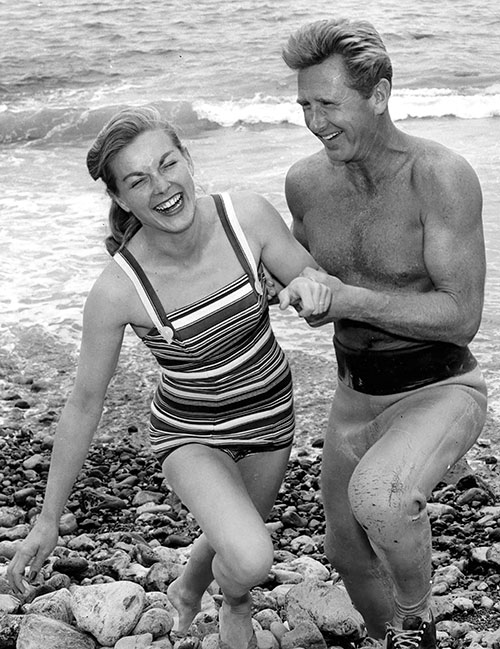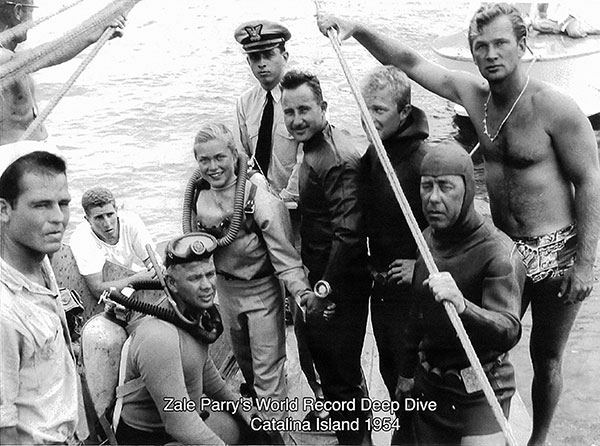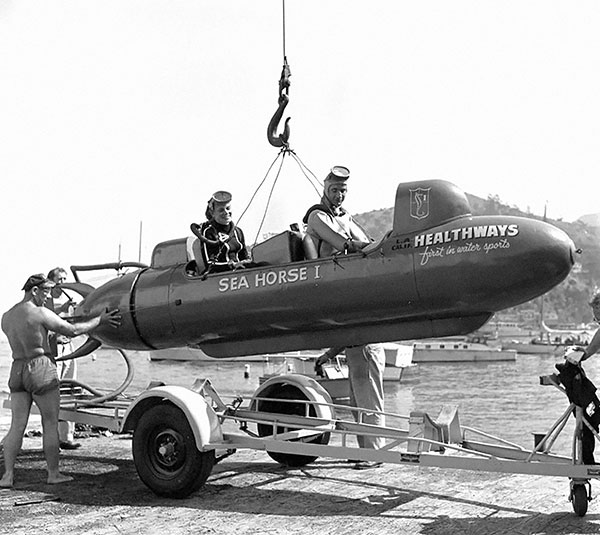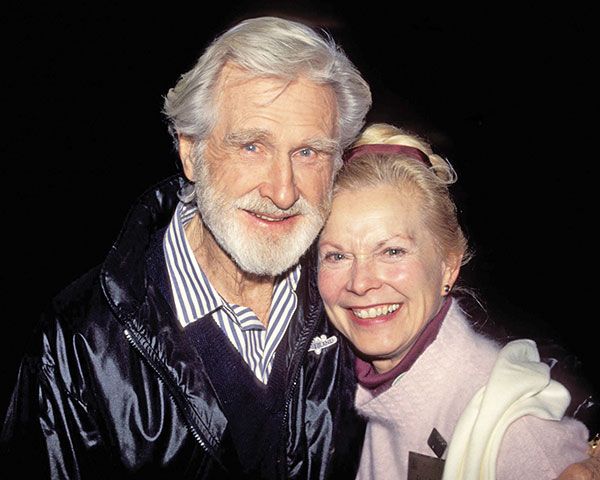Thrill of the Hunt
60 years after it first aired, Sea Hunt’s leading lady recounts some of her experiences on the TV show that made diving a star – Words by Zale Parry

The television series Sea Hunt came along at a point in time when television itself was just emerging as the great mass entertainment media of all time. There was a mere handful of stations to choose from: ABC, NBC, CBS, and Public Broadcasting. All analog at the time and free. Today we may choose from hundreds of channels because of the digital reinvention of everything.
Westerns were extremely popular in the ’50s and Sea Hunt was in many ways an underwater Western. The viewing public was extremely receptive to the portrayal of lone wolf type of heroes. It also was at a time when scuba diving was just starting to pick up significant number of people. The personal ownership of your own tank and regulator had become part of the American life-style.
Sea Hunt was not filmed in colour. Colour film and processing were too expensive. It didn’t matter. Those who watched felt the adventure, the unknown aspect and the challenge of a new sport. Disney brought the colour, yet “Uncle Milty” with his Texaco half hour and I Love Lucy with her humorous episodes ran second to our beloved Sea Hunt.
It was in this context, emerging from the austerity of WWII, that Skin Diver Magazine was born. Breath-hold diving was all the rage for the dinner catch. Diving clubs were popping up throughout the United States. And, the Underwater Demolition Team (UDT) Unit One on Coronado Island, California, was operating under Cmdr. Francis Douglas Fane.
Early on
I was very involved in diving from its start. Breath-hold was easy for me, since I was dedicated to synchronized swimming in school. I met Parry Bivens on a blind date, we fell in love, built a 22-foot (6.7m) Jeffries ocean boat and then we married. Yup, that’s the way things worked out. We spent days underwater.
As a Berkeley-educated structural engineer, scientist, and medical student to boot, Parry designed and built two portable recompression/decompression chambers to be used as a safety factor for treatment of the bends if needed by civilians.
That was good, as least I thought! The UDT needed one. But Cmdr. Fane couldn’t convince the United States Department of the Navy that he not only needed a chamber for his frogmen’s safety factor, he wanted one. The Navy had no funds for a chamber. Big disappointment for him and for us.

Hospitals throughout the United States weren’t interested in recompression/decompression chambers either. Doctors didn’t know or care to know about decompression sickness. We were just too early in the game to save lives.
As it was, the U.S. Atomic Energy Commission purchased the single lock chamber for Eniwetok in the Marshall Islands, to be used by military personnel who used their R&R sport diving. The other, a double-lock chamber, we sold to an off-shore oil drilling company off Maracaibo, Venezuela. That was 1957, the end of our Scientific Underwater Research Enterprise (SURE).
Sea Hunt’s producer, Ivan Tors, met Fane through my husband (who was by this time Dr. Parry Bivens) and me on another matter. Tors was very impressed with Fane. Tors asked in his heavy Hungarian accent, “Vot vill you do as a civilian, Doug?” Fane, a rough-and-ready red dog, replied, “I’d probably get a boat and hire myself out…search, rescue, detective, stuff like that.”
It wasn’t long before Tors, who was a writer for Science Fiction Theater, produced Doug Fane’s life story in the film Underwater Warrior with actor Dan Daley as Fane. I was Mrs. Fane underwater. The film became the genesis for Sea Hunt.
Without demonstrating my acting or aquatic ability, I was hired by Tors over the telephone. I had just completed Kingdom of the Sea, a Jack Douglas Production series with Col. John D. Craig. The next day after the phone call, I went to Tors’ office for an interview. All he asked was, “Do you vant to verk vit me?” Of course, I said, “Yes, happy to work with you.”
Then Tors began searching for an affordable, veteran actor who was athletic to be the main character, Mike Nelson. There was Lloyd Bridges, a journeyman actor. Lloyd was interested in a Western series, but Tors convinced him to work for him.
Lloyd was blonde, well-built, looked great in a wet bathing suit in the sun. Excellent athlete. Tennis was his game.
My first introduction to Lloyd Bridges was at Marineland of the Pacific for the first studio call for publicity photos. Lloyd was pleasant, a perfect gentleman and easy to work with for the day. Lloyd was an authentic actor and a Shakespearean actor, too. Was he a diver? NO. But he would often ask me as he was learning, “Am I doing this right?” He was a quick learner.
I was impressed with the attention he paid toward the professional way of doing diving. His diving was done mainly in a tank on stage for close-ups. As an excellent swimmer, the call sheet would have Lloyd in the sea, especially for surface shots, on location.
So while Lloyd would be the perfect image of Mike Nelson on the surface and for underwater closeups, veteran diver stand-in Courtney Brown would do the actual diving footage. All of it.
Standing in
Enter Ricou Browning, who was a graceful, strong swimmer, platform and underwater diver out of Florida waters. He doubled the actors who were filmed on location for the second unit. The first unit most often was on stage in and around Hollywood. This included the beaches and Catalina Island, and of course, Marineland of the Pacific was used at first.
Ricou really knew the territory in his state. He knew the owners of Silver Springs, Florida, where much of the underwater filming took place. Later we filmed in the Bahamas for a while. Tors hired him to be their location diving expert. Ricou would eventually be the star in The
Creature from the Black Lagoon.
The other villains were played by our underwater director, Paul Stader; Norm Bishop; Jon Lindbergh, son of Charles Lindbergh; and Bill Boyett. Bob and Bill Meistrell, of Body Glove fame, assisted us when we were on the West Coast, especially at Marineland. Of course, they made all the wet suits. Black suit for the bad guy…and girl. Grey for the good.
Leonard Nemoy, later of Star Trek, Larry Hagman, later of the television series Dallas, and many of the up-coming stars for other programs did the dry acting. Ivan Tors really put those actors on the map.
Soon the production list was becoming more complicated. Tors had the studio fly Cmdr. Fane, underwater photographer Lamar Boren, and six top UDT divers to the Marshall Islands. There they were to get stock footage of sharks in their every swimming style or smile.
“They sniffed us like dogs,” Fane later said. What was shown on the show was the actual footage. Nothing faked. That footage was interspersed into Sea Hunt episodes every time a shark was on the call sheet. Although a few times a sleepy real shark was pushed in front of the Sea Hunt camera lens for close-up drama during actual filming.
For the dialogue topside when Mike Nelson didn’t need to get into the water, he and the actors on ‘stage’ wore double balsa wooden tanks with the real valve and regulator, made so perfectly-proper by the studio, it was not easy to tell the difference. Until you picked them up.
Everything was ripe and primed for a Mike Nelson to come on the scene and become the inspiring hero.
The very first week of honest filming in the ocean, we were working off a barge near Whites Landing, Catalina Island. Our Property Master, fresh off a Western movie, was to keep track of the holder and gun for each actor who needed them. He did not know divers. He did not know diving equipment. Zero.
All the masks, fins and regulators were lined up for us. Nothing was connected. But we knew what we were to wear, so we gathered our equipment ourselves. The Property Master watched intently…almost irritated. The Cameraman and Director were in the water first. We followed.
After a while, my scenes were complete. I came up the ladder, handed my mask to Mr. Blaine, the Property Master, then my fins. He helped me remove the tank and we chatted. Never in his life in his work in the industry had he ever come across actors of our sort, he told me. First you spit in your mask, and place it in a pail of water; then any regulator, never knowing or caring who used it before you; and no one has used the head on board! (There he finally paused for breath….)
We never worked with him – nor he with us – again!

Hard work
Sea Hunt came along and personalized the experience of going underwater. It gave everybody someone to emulate. Scuba was the real star. We think everybody had fun watching a scuba diver put into harm’s way, following the common plot lines of cops and robbers and Westerns.
Making pictures underwater is physically consuming. We boarded and dropped off boats or barges dozens of times. In the winter when we were using the Silver Springs location, we dived in and out of a glass bottom boat. The air was cold and the water temperature was 72 degrees Fahrenheit (22°C). So the glass was removed from the boat and a ladder extended into the water. In the boat there were heaters. We wore terrycloth robes while new direction was given.
Our underwater cameraman, Lamar Boren, who was an exceptionally agile diver for his larger size, had to be well-balanced to obtain some of the tricky angles of the scene. Next time you see an episode of Sea Hunt, ask yourself, “Where is Lamar?” For the storyline about the kelp cutter, for instance, Lamar is strapped above the blades under a huge kelp cutter vessel!
Many times to finish a sequence, fresh tanks of air were exchanged underwater. We never really thought about “Who used that regulator last?” Neither could film production wait for proper procedures to remove weight belts to secure tank straps under the weight belts. We wore our dive weights under our tanks because time was vital. We placed an episode in the can (Hollywood talk) every four days. Sometimes we would work on two scripts at a time. We filmed from sunrise to sunset with some night shots, six days a week. Time is a big issue in the film business.
Sometimes we were dropped by helicopter a grand distance from the film boat. During the ‘50’s we were certain Orcas ate people, so I kept a look out for dorsal fins! As for sharks, we didn’t see any and trusted they lived elsewhere!

On Sundays we had access to the Everglades Speed Boat owned by Bill and Patty Boyett and did the pyramid act with three single water skiers. Imagine so much fun! I was the light-weight top turtle.
We received a lot of letters. Throughout America, experienced divers found fault with some of the diving behaviour of Mike Nelson. Notice no snorkels. They became popular in the mid 1950’s. Mike Nelson didn’t need a snorkel! “Hey! Why is he diving alone? How about ‘Always dive with a buddy’”? Sometimes, the hero would leap in the water with one tank and then be seen with two tanks, at which the adult, veteran divers would hoot. But the kids loved it, flaws and all.
The cast was set. In 1958, when CBS’s Sea Hunt presented the adventures of Mike Nelson played by Lloyd Bridges, young girls and boys hurried home from school to finish homework, not to miss an episode. Vocations pertaining to the sea were conceived watching Sea
Hunt. It provided the most wholesome, exciting, and educational series for a long run…not only in the United States but syndicated in 78 countries.
Sea Hunt continued to play on television through the 1970’s around the world. It cruised along at ratings’ peak and was dearly missed by 15 million viewers a week when the last season died. Today the entire series can be purchased on DVD.
Lloyd Bridges remained an inspiring hero in the public’s mind and received many diving awards for creating a luring, exciting, ultimate recruiting vehicle for the sport.
Some people go to the Holy Land to believe. Some people go to Hollywood to make believe. We went to Hollywood, but what you saw underwater really happened. Nothing in television underwater drama ever again approached Sea Hunt’s influence. Yes, it was once upon a time. Hold it tight!
Zale Parry is a pioneer scuba diver, underwater photographer, actor, and writer. She made her screen debut in 1954, the same year she set a women’s depth record to 209 feet (63.7m). She went on to have a successful acting career and is still very active in her support of the sport diving community.
One Response to “Thrill of the Hunt”
Leave a Comment








Frances Blundell
I became a diver in my late teens after regularly watching Sea Hunt as a child & continued diving for many years until 2010. Thank you Mike Nelson.